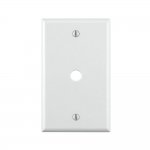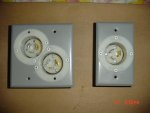Hoping this is related enough to ask here, and not start a new thread . . .
For a wall-mounted TV installation, I usually place a typical old-work box with a standard or recessed receptacle behind the TV, with a length of 14-2 NM fed from a second old-work box installed below, at normal receptacle height. In this box, I run a power cord through a 1-hole wall plate and wire-nut the conductors to the 14-2.
I have in effect constructed an in-wall extension cord made with code-compliant in-wall components. The customer then plugs the cord into whatever power strip or surge protector the rest of the audio/video equipment plugs into, providing the same protection and avoiding any chance of different-circuit electrical noise or currents.
My question is whether the NEC has jurisdiction over, or rules covering such an installation. Having no direct connection to the premises wiring, is it nonetheless an installation that, technically speaking, is subject to permitting and inspection requirements? I have seen similar in-wall kits that actually use a rubber extension cord.


